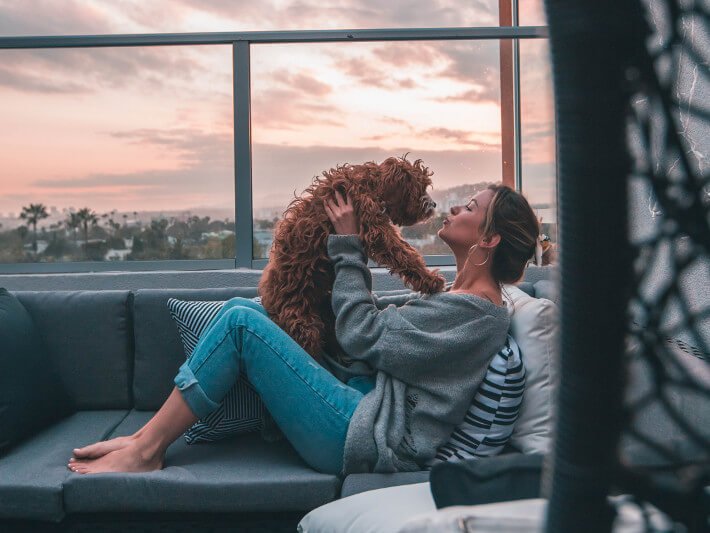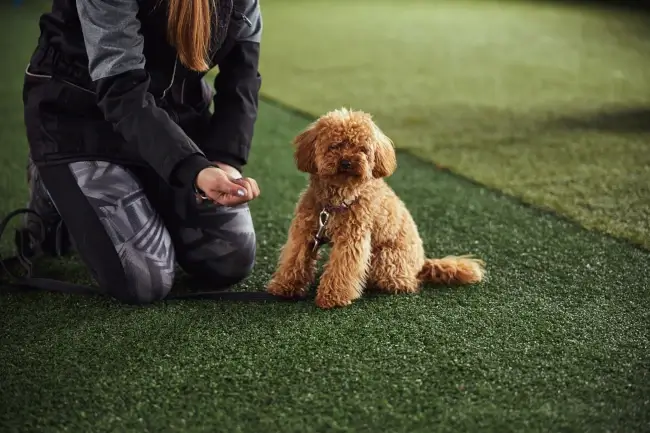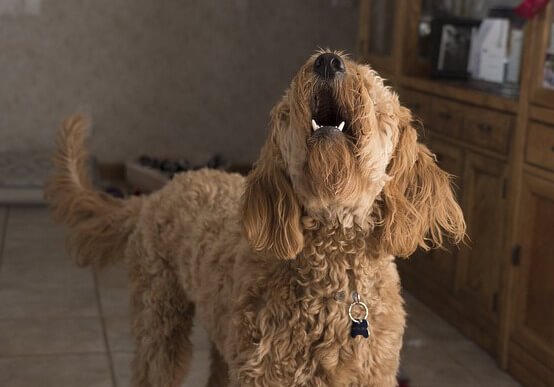Cavapoo Recall Training: Building a Strong Response

What is dog recall training, you might ask?
Dog recall training, essentially, is teaching your dog to come when called. It’s a vital command every dog, and particularly your Cavapoo, should master.
Why is it so crucial?
Well, having a dog that promptly comes when called not only offers convenience during everyday interactions but, more importantly, it ensures your dog’s safety in potentially dangerous situations.
In this comprehensive guide, we’ll delve into the essential steps for recall training, starting from understanding what it is, moving onto the basics of the training itself, and then exploring a variety of exercises that can help reinforce this command.
Whether you are a first-time Cavapoo owner or just looking to enhance your dog’s recall skills, this article will serve as a practical resource for you.
Let’s dive in!
Understanding Recall Training
Dog recall training is the process of teaching your dog to come back to you immediately when called, regardless of what they’re doing or the distractions present in the environment.
It’s an essential part of a dog’s training regimen, playing a critical role in ensuring the safety and well-being of your Cavapoo.
Recall training isn’t simply about your convenience or asserting dominance over your canine friend; it’s about instilling a sense of trust and building a solid connection.
When your dog understands and responds to the recall command, it signifies that they trust your guidance and view you as their secure base.
This obedience exercise also serves as a lifesaver in many situations.
Imagine if your dog is about to run into a busy road, chase after another animal, or approach a potentially dangerous situation.
A well-taught recall command can immediately stop them in their tracks and bring them back to the safety of your side.
It’s beneficial across all stages of a dog’s life.
Whether you have a playful puppy, an energetic adult, or a senior dog, recall training is essential.
Just note though that successful recall training doesn’t happen overnight.
It takes time, patience, consistency, and positive reinforcement.
Over time, this training will become deeply ingrained in your dog, becoming an instinctive response.
In the following sections, we’ll delve deeper into how to conduct recall training, various exercises you can try, and how to overcome challenges that may arise.
Recall training is a journey you undertake with your Cavapoo, one that will strengthen your bond and help create a safe, enjoyable life together.

The Basics of Recall Training
Recall training is a progressive process and begins with understanding your dog’s motivations and reinforcing positive behavior.
Here are some fundamentals to consider when starting out:
Start Early But Do Not Rush Things
Early training for puppies is beneficial, but don’t rush it.
Begin once your new puppy is settled and comfortable in their new environment.
But, recall training isn’t exclusive to puppies.
You can teach older dogs as well, proving the adage ‘you can’t teach an old dog new tricks’ wrong!
Choosing a Command
Decide on a specific command for recall.
This could be as simple as your Cavapoo’s name followed by “come”, or even just “here”.
Ensure that it’s short, distinct, and not similar to other commands you use.
Consistency is key, so once you choose a command, stick with it.
Encourage other members of the household to use the same words to avoid confusion.
Selecting the Right Environment
Initially, start training in a quiet, controlled environment with few distractions.
This could be your backyard or even inside your house.
As your dog gets more confident and consistent with their response, gradually introduce more distractions and varied locations.
Positive Reinforcement
This is the cornerstone of successful recall training.
Reward your Cavapoo each time they come to you when called.
Rewards can be in the form of treats, praise, or a favorite toy – anything that your dog loves.
This helps your dog associate the recall command with positive outcomes.
Patience and Practice
Training takes time and patience.
There may be setbacks, but that’s perfectly normal.
Consistent practice is vital, and it’s better to have short, frequent training sessions rather than long, infrequent ones.
Remember, successful recall training involves clear communication between you and your dog.
As a handler, you need to be aware of your body language, tone of voice, and even your mood, as dogs are very attuned to these signals.
Above all, make recall training a fun and rewarding experience for your Cavapoo, and you’ll see improvements over time.
As we dive into specific recall training exercises in the following sections, you’ll notice these basics form the foundation of each activity.
Keep these principles in mind, and you’ll be well on your way to successfully training your dog to come when called.

Recall Training Exercises
Recall training exercises are designed to reinforce the command for your Cavapoo to come to you, while also making the process enjoyable for them.
Each exercise utilizes different elements of play and motivation, providing a varied approach that keeps your dog engaged.
The Leash and Call
This is a basic recall exercise where you begin with your dog on a leash.
Rather use a harness instead of a collar as it is more gentle on your dog’s neck and throat.
First, get your dog’s attention.
You’ll give your recall command, such as “come” or “here”, and then gently pull on the leash to guide your dog towards you.
Each time your dog comes, reward them with a treat or praise.
As they start to understand the command and respond more consistently, increase the distance between you and your dog and introduce a long line if needed.
The Hide and Seek Game
Turn recall training into a game to make it more engaging for your Cavapoo.
In this exercise, you’ll hide somewhere in your home, then call your dog.
The aim of the game is for them to find you based on your recall command.
When your dog locates you, reward them generously with praise, play, or a treat.
This exercise not only improves recall but also helps your Cavapoo enhance their problem-solving and scent tracking skills.
The Food Lure
If your dog is motivated by food, this exercise can be especially effective.
Hold your dog’s favorite treat in your hand and move away from them.
When you’re at a distance, give your recall command.
As your dog comes to you, reward them with the treat.
Make sure the treats you use are healthy and that you account for these extras when calculating your dog’s daily food intake.

The Run Away and Call
This exercise involves some physical activity on your part.
Call your Cavapoo with your chosen recall command and then immediately turn around and run in the opposite direction.
Most dogs have a natural instinct to chase, so your dog should start running after you.
Once they catch up, reward them with a treat, toy, or praise.
This exercise not only improves your dog’s recall but also provides them with some good physical exercise.
I actually used this very same technique on a rescue Cocker that I had.
She was a distance away from me and when I called her she did not respond.
I then called her again and turned around and started running away from her.
She immediately stopped what she was doing and ran at the speed of light to me.
It worked perfectly! So, give it a try.
The Toy Temptation
For dogs that are particularly toy-motivated, this exercise can be a great addition to your training routine.
Begin by engaging with your dog’s favorite toy.
After a short play session, throw the toy and as your dog goes to retrieve it, give your recall command.
When your dog comes back to you with the toy, engage in more play as a reward.
This exercise combines recall training with fetch, making it a fun and rewarding experience for your dog.
These exercises add variety to your recall training routine, which can help keep your dog engaged and motivated.
Remember to always end on a positive note, even if it means finishing with an easy task that your dog can successfully complete.
This way, your dog will associate recall training with positive experiences and be more enthusiastic about future sessions.
Utilizing a Long Line for Recall Training
A long line is a valuable tool in the early stages of recall training, providing a safe and controlled way to teach your dog the recall command.
It allows your dog to explore while giving you the control to guide and correct their actions.
What is a Long Line?
A long line, also referred to as a training line or a check cord, is a type of leash that can range from 10 to 50 feet long.
It’s typically made of light, durable materials that can handle different types of environments, from backyards to parks, and even water.
Click HERE for More Details at Amazon.com
Why Use a Long Line?
Using a long line for recall training allows your dog to experience a sense of freedom while still being under your control.
This way, they can explore and move further away from you, but you can easily guide them back when you give the recall command.
How to Use a Long Line Safely and Effectively
Here are some tips to use a long line properly and safely during recall training:
Choose the Right Long Line: Look for a line that’s the appropriate length for your training environment.
It should be long enough for your dog to roam but not so long that it gets easily tangled.
It should also have a comfortable grip and be made of a durable material that can withstand your dog’s strength and energy.
Introduce the Long Line Gradually: Just like any new training tool, allow your dog to get used to the long line gradually.
Start by letting them explore while attached to the line, without giving any commands.
Once they seem comfortable, you can start incorporating the recall training.
Keep the Line Slack: When your dog is exploring, keep the long line slack.
A tight line may make your dog feel restrained and defeat the purpose of the perceived freedom a long line offers.
Prompt and Guide: Use the long line to guide your dog back to you when you give the recall command.
A gentle pull is often all that’s needed.
Never Use the Long Line for Correction: The long line is a tool for guidance, not correction.
A harsh tug can scare your dog or even lead to injury.
Always use gentle, consistent pulls to guide your dog back to you.

Safety Tips for Using a Long Line
Be Aware of Your Surroundings: Be mindful of the environment when using a long line. Avoid areas where the line can get tangled easily, such as dense bushes or crowded parks.
Be Mindful of Other People and Dogs: If you’re training in a public area, be aware of other people and dogs. A long line can inadvertently trip someone or get tangled with another dog.
Protect Your Hands: If your dog bolts, the line can quickly pull through your hands and cause burns or cuts. Consider wearing gloves or choose a line with a comfortable grip.
A long line is a useful tool in recall training, bridging the gap between on-leash and off-leash training.
It offers your Cavapoo a sense of freedom while allowing you to maintain control during training sessions, thus making the transition to off-leash recall smoother and safer.
Clicker Training
Clicker training is a popular positive reinforcement training method that can be used to teach your dog a reliable recall.
The clicker is a small plastic device that makes a clicking sound when pressed.
It’s used to mark the exact moment when your dog performs the desired behavior, such as coming when called.
To use a clicker for recall training, start by training your dog to associate the sound of the clicker with a reward.
Click the clicker and immediately give your dog a high-value reward, such as a piece of chicken or cheese.
Repeat this several times until your dog understands that the clicker sound means a reward is coming.
Once your dog has made this association, you can start using the clicker to mark the moment when your dog comes to you.
Click the clicker as soon as your dog starts moving towards you, and then immediately give them a reward when they reach you.
Over time, your Cavapoo will learn that coming when called is a behavior that earns them a reward.

Overcoming Recall Training Challenges
Every dog is unique, and each may face different challenges in their recall training journey.
There are several common obstacles that many dog owners face.
Understanding these challenges and how to address them can significantly enhance your recall training effectiveness.
Inconsistent Response
One of the most common issues is inconsistency in the dog’s response.
This can often stem from a lack of understanding or confusion about the recall command.
If this happens, revisit the basics of recall training.
Ensure your command is distinct and not similar to other commands.
Consistently reward your dog when they come to you, to strengthen the positive association.
Distractions
All dogs can be easily distracted, especially in environments with lots of stimuli like other dogs, people, or wildlife.
Start training in a quiet, controlled environment, and as your dog’s recall improves, slowly introduce them to more distracting settings.
Gradually increasing the level of distraction helps your dog learn to respond to the recall command, even in trying environments.
Fear or Anxiety
If your dog seems fearful or anxious during training, it can hinder their learning process.
Make sure you’re not using the recall command in a negative or punitive context.
The recall command should always result in something positive for your dog.
If your dog associates it with an end to playtime or being reprimanded, they may become reluctant to respond.
Lack of Motivation
Just like humans, dogs can have days where they seem uninterested or unmotivated.
On such days, it’s best to keep the training session short and end on a high note.
Consider using high-value rewards like your dog’s favorite treat or toy to boost motivation.
Stubbornness
Some dogs can be more stubborn or independent than others.
Consistency and patience are key with these dogs.
Regular short training sessions, positive reinforcement, and avoiding pushing them too far, too fast can help.
Training a dog to have a reliable recall is one of the most challenging aspects of dog training, but it’s also one of the most rewarding.
It will take time, patience, and consistency.
Remember, all dogs learn at their own pace.
Celebrate small victories, and don’t be discouraged by setbacks.
Every step forward, no matter how small, is progress in your dog’s recall training journey.

Maintaining Your Dog’s Recall Ability
Once you’ve made progress in recall training, it’s essential to maintain your Cavapoo’s new skill.
Like any other learned behavior, the reliability of your dog’s recall can fade over time if not consistently reinforced and practiced.
Regular practice is crucial for maintaining your dog’s recall ability.
Incorporate recall commands into your daily routine, such as mealtimes, playtime, or before going for a walk.
It doesn’t always have to be in a structured training session.
The aim is to keep the recall command fresh in your dog’s mind.
Wrapping It Up
Training your dog to come when called is one of the most important skills your Cavapoo can master.
It’s about more than just convenience – it’s about safety.
I have learned that teaching a dog to come when called is not only important for their safety, but it also strengthens the bond between the dog and their owner.
Training recall may seem daunting, but remember, it’s a gradual process.
Start with the basics and gradually add complexity as your dog becomes more confident and consistent.
Utilize tools like a long line for added control during initial stages, and incorporate a variety of exercises to keep the training engaging and fun.
Encountering challenges is a normal part of the training process.
Whether it’s dealing with distractions or overcoming a stubborn streak, stay patient and persistent.
Every dog learns at their own pace, and the progress you make, no matter how small it may seem, is a step towards a reliable recall.
Remember, training doesn’t stop once your dog has mastered recall.
Consistent practice in different environments, reinforcing positive behavior, and progressively challenging your dog will help maintain this invaluable skill.
With time, patience, and consistency, you’ll be able to nurture a strong, reliable recall in your dog, providing you with peace of mind and your dog with the freedom to explore, safe in the knowledge that they will return to you when called.








Hi Irma, thanks for your great articles. I’m wondering if you might give me a bit of advice.
I’m thinking about welcoming another dog, and am interested in Cavaliers or Cavapoos.
We have a small, ethical Cavalier breeder nearby, who focuses on home raised puppies from parents who’ve been genetically tested and chosen for lower chances of mitral valve and eye diseases. However, in reading comments from Cavalier owners (in general, not from this breeder) they repeatedly mention the heartbreak of their dogs suffering greatly from major health problems by the age of 10.
In your opinion, is genetic testing and careful screening of parents effective in significantly lowering the chances of this?
Thanks for any advice you can offer!
Hi Rebecca,
Cavaliers in general have a lot of health issues. We had to put one of ours to sleep a month ago. She had MVD, SM and Addison’s disease and she was only 6 years old 🙁
I think I saw a statistic that over 85% of Cavaliers carry or have a genetic disease.
Never mind the fact that their small, snubby noses cause breathing problems as well.
A breeder that does all the health testing is obviously the way to go BUT it does not eliminate the risk entirely.
There is still a risk of genetic diseases cropping up as they can skip generations.
It just makes the risk lower.
That is why I love Cavapoos because the risk is even lower with this mix breed.
It still can happen that a puppy can inherit MVD or SM but the risks are a lot lower.